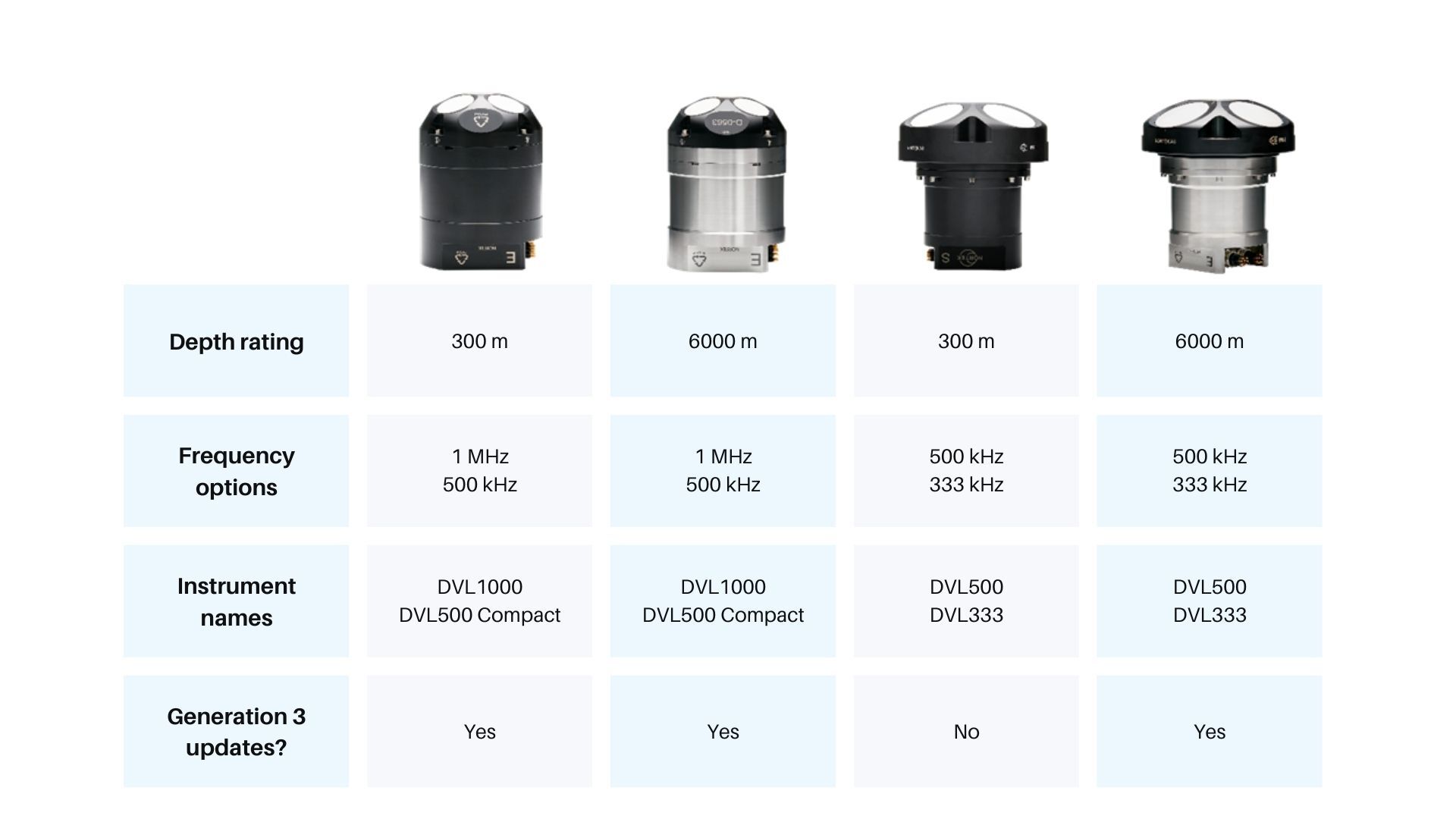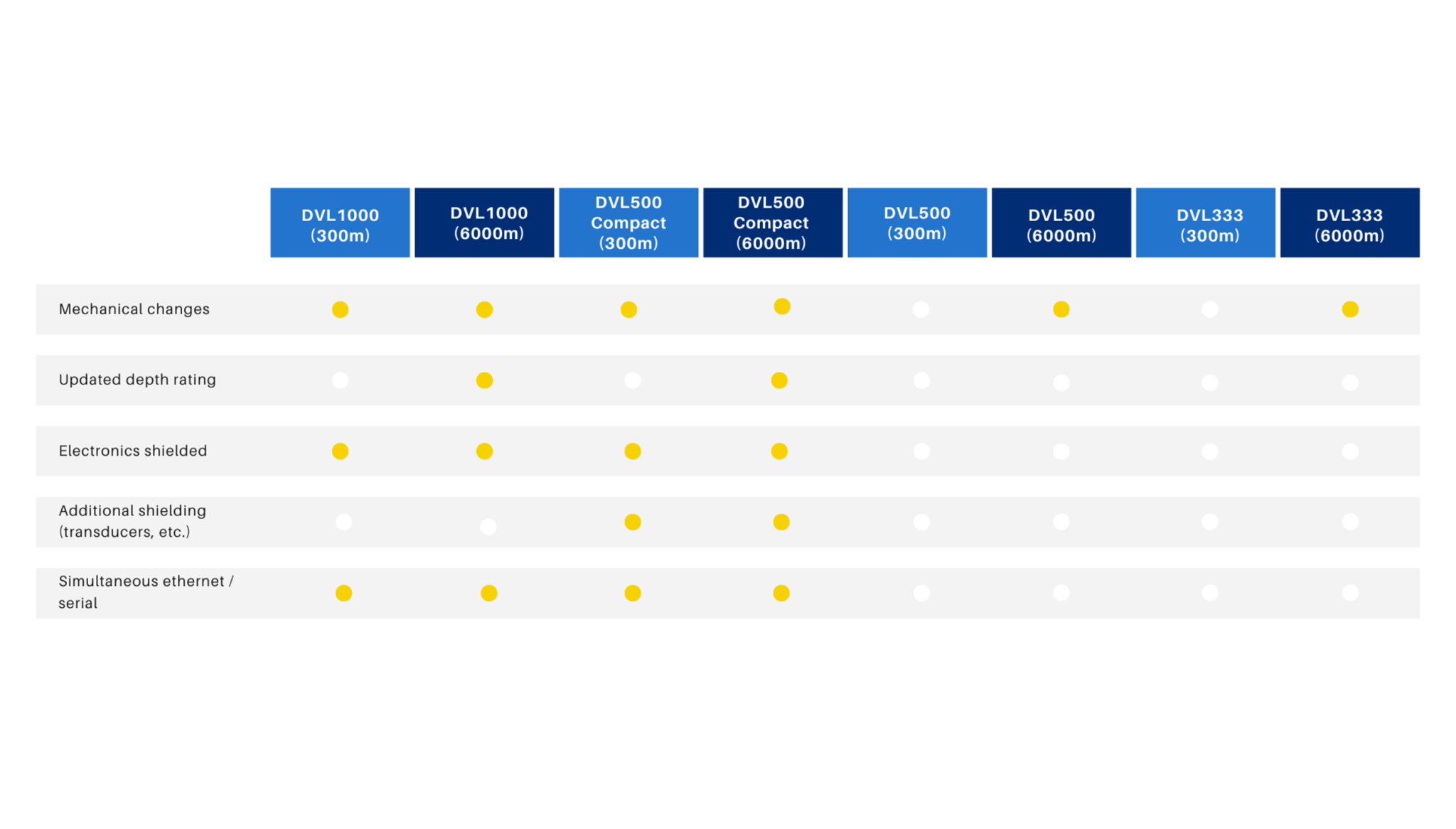DVL Generation 3 Release Notes
Nortek released Generation 3 of the DVL series in 2024. Below are the key updates and changes associated with the new generation.
1. Why did we make a new version of these instruments?
Since the release of the original DVL product range in 2015, Nortek has expanded the product range to better suit a wider range of vehicle designs and applications, including more options for mechanical design and frequency of operation. Additional capabilities and performance improvements have been incorporated in the DVL; however, these improvements have primarily been through firmware until recently.
Nortek has now taken advantage of advances in transducer design and manufacturing techniques to create a new generation of DVLs with improved performance and future-proof electronics. In this redesign, we have also simplified the product line to streamline production.
2. Which DVLs are now considered Generation 3? What updates have been made?
Nortek’s DVLs can be divided into four form factors seen in the first chart below. Because different applications demand different DVL capabilities, the updates applied to this product line are not entirely uniform across all instruments.
The DVLs that have undergone some level of redesign are now known as Generation 3. The only DVLs which have not undergone Generation 3 updates are the 300m versions of the DVL 500 and DVL 333.
The specific Generation 3 changes vary by instrument. The second chart below outlines the changes made to each instrument compared to the most recent DVL version.


3. Specific changes by instrument
3.1 DVL 1000 (300 m)
- Changes:
- Minor mechanical redesign to accommodate additional internal electronics shielding, improving noise management.
- Simultaneous serial and ethernet output enabled (serial Tx only).
- Improved minimum altitude of 10 cm.
- Optimized for:
- Use on smaller, shallow-water ROVs and AUVs that have limited payload space where the DVL may be positioned in close proximity to thrusters or a power supply.
3.2 DVL 1000 (6000 m)
- Changes:
- Mechanical redesign to enable extended depth rating of 6000m (previously 4000m*).
- Connectors isolated from titanium housing with POM sleeve.
- Simultaneous serial and ethernet output enabled (serial Tx only).
- Improved minimum altitude of10 cm.
- Optimized for:
- Continued use in survey market on high-end ROVs using other acoustic survey systems.
3.3 DVL 500 Compact (6000 m and 300 m)
- Changes:
- Mechanical redesign to enable extended depth rating of 6000m (previously 4000m*).
- Addition of extensive component and transducer shielding to enable simultaneous ethernet and serial output (serial Tx only).
- Connectors isolated from titanium housing with POM sleeve (6000m version).
- Improved minimum altitude of 10cm.
- Optimized for:
- Use on advanced AUVs and ROVs requiring flexible communication options and the best possible minimum and maximum operational ranges from a DVL.
3.4 DVL 500 (6000 m) and DVL 333 (6000 m)
- Changes:
- Minor mechanical redesign to accommodate improved head design.
- Improved minimum altitude of 10 cm.
- Optimized for:
- Use on large, long-range AUVs which repeatedly dive to extreme depths.
4. Firmware updates
All Generation 3 DVLs are equipped with the latest firmware release, which includes:
- Additional PDx data formats to support legacy work-class ROVs: PD0, 4, 5, 6 + NMEA and Nortek format DF21/22.
- New bottom tracking “Auto” mode that automatically switches between nearbed detection and normal operation based on detection of low altitude and low velocity criteria.
- Improved minimum operational altitude of 10cm.
5. Compatibility
While some of the Generation 3 designs have different weights and dimensions than previous DVLs, all mounting arrangements and bolt patterns are the same. This means existing interface equipment can still be used with Generation 3 DVLs**.
For those interfacing with Inertial Navigation Systems (INS), it should be noted that the Generation 3 6000m versions of the DVL 1000 and DVL 500 Compact have different center points for DVL / INS calibration. This means different offset values are required during INS configuration. DVL to INS interface plates are still available and remain unchanged. DVL to INS cables will be provided as an in-line configuration, rather than the previous right-angle connector on the INS end. Connectors are now titanium for improved robustness. If you require assistance with DVL / INS interfacing, please contact your local Nortek office.
Protective head cages are still available, now in two depth rating variants for the 300m and 6000m instruments. These are only compatible with the DVL 1000 and DVL 500 Compact.
To see drawings, weights and dimensions of Generation 3 DVLs, please visit the product pages on our website.
* Existing 4000 m systems cannot be upgraded to 6000 m versions.
** Users of the Schilling variant of the DVL 500 Compact should note that the mounting arrangement now matches other Nortek DVLs and uses imperial bolt sizing.